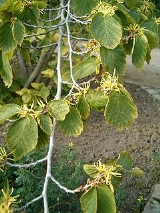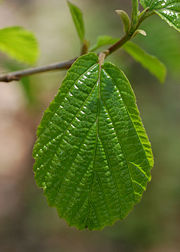
Hamamelis virginiana
Encyclopedia
Hamamelis virginiana is a species of Witch-hazel
native to eastern North America
, from Nova Scotia
west to Minnesota
, and south to central Florida
to eastern Texas
.
It is a deciduous
large shrub
growing to 6 m (rarely to 10 m) tall, with a dense cluster of stems from the base. The bark
is light brown, smooth, scaly, inner bark reddish purple. The branchlets are pubescent at first, later smooth, light orange brown, marked with occasional white dots, finally dark or reddish brown. The foliage buds are acute, slightly falcate, downy, light brown. The leaves
are oval, 3.7–16.7 cm long and 2.5–13 cm broad, oblique at the base, acute or rounded at the apex, with a wavy-toothed or shallowly lobed margin, and a short, stout petiole 6–15 mm long; the midrib is more or less hairy, stout, with six to seven pairs of primary veins. The young leaves open involute, covered with stellate rusty down; when full grown, they are dark green above, and paler beneath. In fall, they turn yellow with rusty spots. The leaf stipule
s are lanceolate, acute; they fall soon after the leaf expands.
 The flower
The flower
s are pale to bright yellow, rarely orange or reddish, with four ribbon-shaped petal
s 10–20 mm long and four short stamens, and grow in clusters; flowering begins in about mid-fall and continues until late fall. The flower calyx is deeply four-parted, very downy, orange brown within, imbricate in bud, persistent, cohering with the base of the ovary. Two or three bractlets appear at base. The fruit
is a hard woody capsule
10–14 mm long, which splits explosively at the apex at maturity one year after pollination, ejecting the two shiny black seed
s up to 10 m distant from the parent plant. It can be distinguished from the related Hamamelis vernalis
by its flowering in fall, not winter.
. The bark and leaves were used by native Americans in the treatment of external inflammations. Pond's Extract
was a popular distillation of the bark in dilute alcohol. The wood is light reddish brown, sapwood nearly white; heavy, hard, close-grained, with a density of 0.68.
Witch-hazel
Witch-hazel is a genus of flowering plants in the family Hamamelidaceae, with three species in North America , and one each in Japan and China...
native to eastern North America
North America
North America is a continent wholly within the Northern Hemisphere and almost wholly within the Western Hemisphere. It is also considered a northern subcontinent of the Americas...
, from Nova Scotia
Nova Scotia
Nova Scotia is one of Canada's three Maritime provinces and is the most populous province in Atlantic Canada. The name of the province is Latin for "New Scotland," but "Nova Scotia" is the recognized, English-language name of the province. The provincial capital is Halifax. Nova Scotia is the...
west to Minnesota
Minnesota
Minnesota is a U.S. state located in the Midwestern United States. The twelfth largest state of the U.S., it is the twenty-first most populous, with 5.3 million residents. Minnesota was carved out of the eastern half of the Minnesota Territory and admitted to the Union as the thirty-second state...
, and south to central Florida
Florida
Florida is a state in the southeastern United States, located on the nation's Atlantic and Gulf coasts. It is bordered to the west by the Gulf of Mexico, to the north by Alabama and Georgia and to the east by the Atlantic Ocean. With a population of 18,801,310 as measured by the 2010 census, it...
to eastern Texas
Texas
Texas is the second largest U.S. state by both area and population, and the largest state by area in the contiguous United States.The name, based on the Caddo word "Tejas" meaning "friends" or "allies", was applied by the Spanish to the Caddo themselves and to the region of their settlement in...
.
It is a deciduous
Deciduous
Deciduous means "falling off at maturity" or "tending to fall off", and is typically used in reference to trees or shrubs that lose their leaves seasonally, and to the shedding of other plant structures such as petals after flowering or fruit when ripe...
large shrub
Shrub
A shrub or bush is distinguished from a tree by its multiple stems and shorter height, usually under 5–6 m tall. A large number of plants may become either shrubs or trees, depending on the growing conditions they experience...
growing to 6 m (rarely to 10 m) tall, with a dense cluster of stems from the base. The bark
Bark
Bark is the outermost layers of stems and roots of woody plants. Plants with bark include trees, woody vines and shrubs. Bark refers to all the tissues outside of the vascular cambium and is a nontechnical term. It overlays the wood and consists of the inner bark and the outer bark. The inner...
is light brown, smooth, scaly, inner bark reddish purple. The branchlets are pubescent at first, later smooth, light orange brown, marked with occasional white dots, finally dark or reddish brown. The foliage buds are acute, slightly falcate, downy, light brown. The leaves
Leaf
A leaf is an organ of a vascular plant, as defined in botanical terms, and in particular in plant morphology. Foliage is a mass noun that refers to leaves as a feature of plants....
are oval, 3.7–16.7 cm long and 2.5–13 cm broad, oblique at the base, acute or rounded at the apex, with a wavy-toothed or shallowly lobed margin, and a short, stout petiole 6–15 mm long; the midrib is more or less hairy, stout, with six to seven pairs of primary veins. The young leaves open involute, covered with stellate rusty down; when full grown, they are dark green above, and paler beneath. In fall, they turn yellow with rusty spots. The leaf stipule
Stipule
In botany, stipule is a term coined by Linnaeus which refers to outgrowths borne on either side of the base of a leafstalk...
s are lanceolate, acute; they fall soon after the leaf expands.

Flower
A flower, sometimes known as a bloom or blossom, is the reproductive structure found in flowering plants . The biological function of a flower is to effect reproduction, usually by providing a mechanism for the union of sperm with eggs...
s are pale to bright yellow, rarely orange or reddish, with four ribbon-shaped petal
Petal
Petals are modified leaves that surround the reproductive parts of flowers. They often are brightly colored or unusually shaped to attract pollinators. Together, all of the petals of a flower are called a corolla. Petals are usually accompanied by another set of special leaves called sepals lying...
s 10–20 mm long and four short stamens, and grow in clusters; flowering begins in about mid-fall and continues until late fall. The flower calyx is deeply four-parted, very downy, orange brown within, imbricate in bud, persistent, cohering with the base of the ovary. Two or three bractlets appear at base. The fruit
Fruit
In broad terms, a fruit is a structure of a plant that contains its seeds.The term has different meanings dependent on context. In non-technical usage, such as food preparation, fruit normally means the fleshy seed-associated structures of certain plants that are sweet and edible in the raw state,...
is a hard woody capsule
Capsule (fruit)
In botany a capsule is a type of simple, dry fruit produced by many species of flowering plants. A capsule is a structure composed of two or more carpels that in most cases is dehiscent, i.e. at maturity, it splits apart to release the seeds within. A few capsules are indehiscent, for example...
10–14 mm long, which splits explosively at the apex at maturity one year after pollination, ejecting the two shiny black seed
Seed
A seed is a small embryonic plant enclosed in a covering called the seed coat, usually with some stored food. It is the product of the ripened ovule of gymnosperm and angiosperm plants which occurs after fertilization and some growth within the mother plant...
s up to 10 m distant from the parent plant. It can be distinguished from the related Hamamelis vernalis
Hamamelis vernalis
Hamamelis vernalis is a species of Witch-hazel native to the Ozark Plateau in central North America, in Missouri, Oklahoma, and Arkansas.It is a deciduous large shrub growing to 4 m tall, spreading by stoloniferous root sprouts...
by its flowering in fall, not winter.
Uses
The forked twigs of Witch Hazel are preferred as divining rods. An extract of the plant is used in the astringent witch hazelWitch Hazel (astringent)
Witch hazel is an astringent produced from the leaves and bark of the North American Witch-hazel shrub , which grows naturally from Nova Scotia west to Ontario, Canada, and south to Florida and Texas in the United States...
. The bark and leaves were used by native Americans in the treatment of external inflammations. Pond's Extract
Pond's Creams
Pond's Cream is a brand of beauty and health care products that is produced by the Ponds Institute which is owned by the multinational company Unilever.-History:...
was a popular distillation of the bark in dilute alcohol. The wood is light reddish brown, sapwood nearly white; heavy, hard, close-grained, with a density of 0.68.

